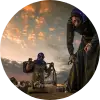
















The Inner Fortress, located in the northeast of Diyarbakır's historical center, is the first settlement and is situated 100 meters above the Tigris River. This fortress, established during the Hurrian period, was restored by Roman Emperor Constantius II in 349 AD. Throughout the rule of the Artuqid Dynasty, it underwent various changes, and during the Ottoman Empire period, it was surrounded by a new wall with sixteen towers.
The Inner Fortress has hosted significant administrative units such as palaces, government buildings, and courthouses. With four main gates, the Inner Fortress's Fetih and Oğrun (Secret Gate) gates open outside the city, while the Saray and Küpeli gates open into the old city within the walls. Additionally, the Virantepe Mound, located northwest of the Inner Fortress, forms the core founding point of the city, where excavations have unearthed Artuqid palace walls, an octagonal pool, and patterned mosaics.
The Artuqid Arch, providing access to the Inner Fortress, is adorned with reliefs symbolizing the struggle between lion and bull and is 10 meters wide. The Saint George Church, situated in the northeast corner, dates back to the 3rd century AD, although its exact construction date is unknown. Within the Inner Fortress, notable sites include the Hazreti Süleyman Mosque, the 19th-century Aslanlı Fountain located just opposite the arched entrance, and the Commander Atatürk Museum and Library.
Highlighted gates within the Inner Fortress include:
Saray Gate: Constructed by the II. Ottoman Governor Divane Hüsrev Pasha, featuring a pointed arch within a rectangular frame. It includes two holes for pouring boiling oil and water on enemies approaching the gate for defense.
Küpeli Gate: Built by Divane Hüsrev Pasha, this gate has a protruding structure in a rectangular form. It is two stories high, and its southern facade is in the shape of a ten-sided tower.
Artuklu Kapısı: The construction date of this gate is understood from inscriptions dating back to the period of Sultan Melik. Currently, it is closed off by walls.
Fetih Gate: Built in 1198 during the reign of Kutbüddin II. Sökmen, known as the gate through which the Islamic army entered after the conquest of Diyarbakır.
Aslanlı Gate: Built during the reign of Artuqid ruler Nasreddin Mahmud in 1206, it contains inscriptions on its southwestern facade.
These gates, displaying architectural diversity, reflect the historical and cultural richness of the Inner Fortress.